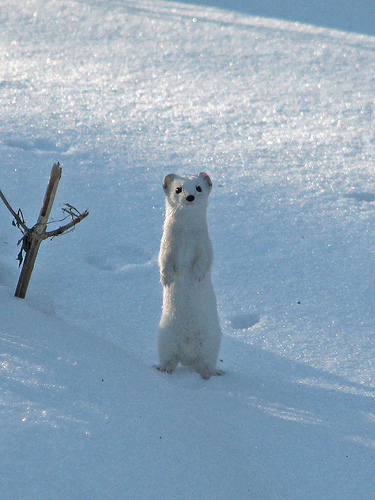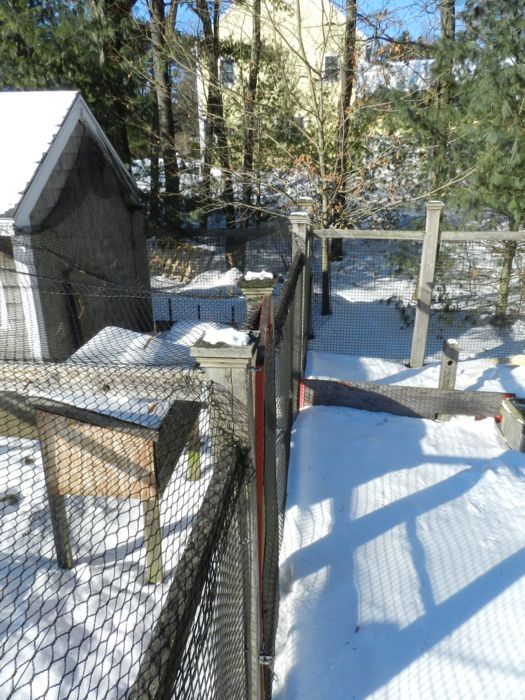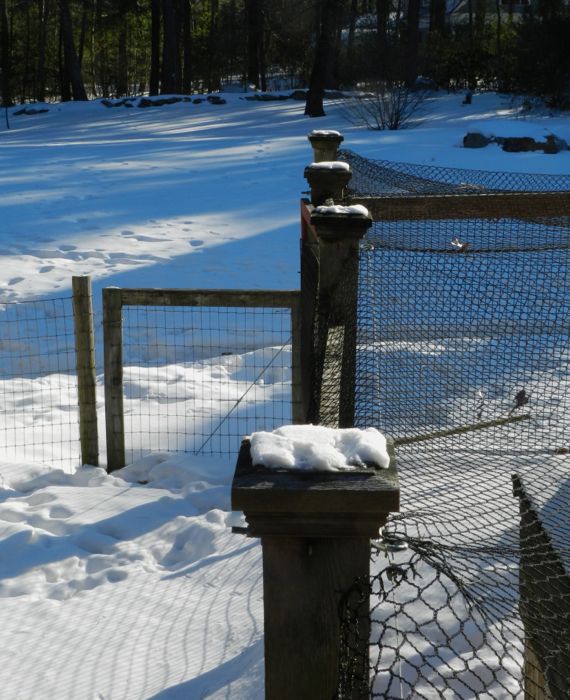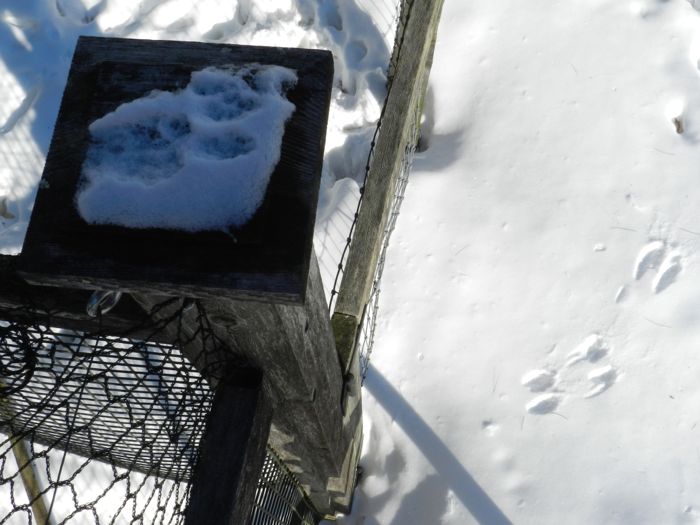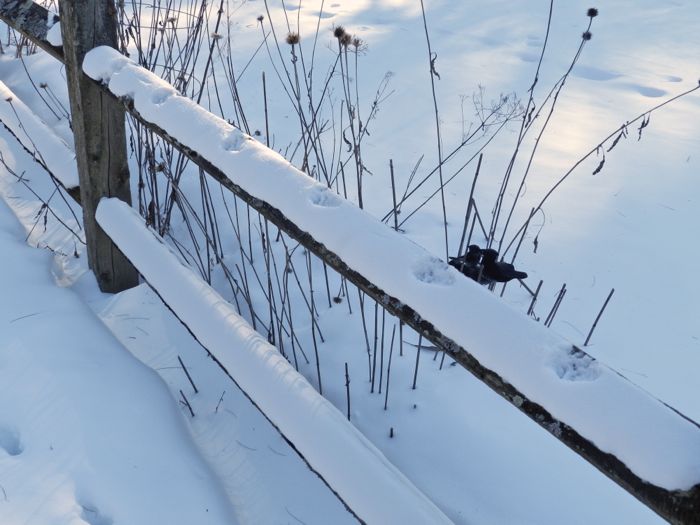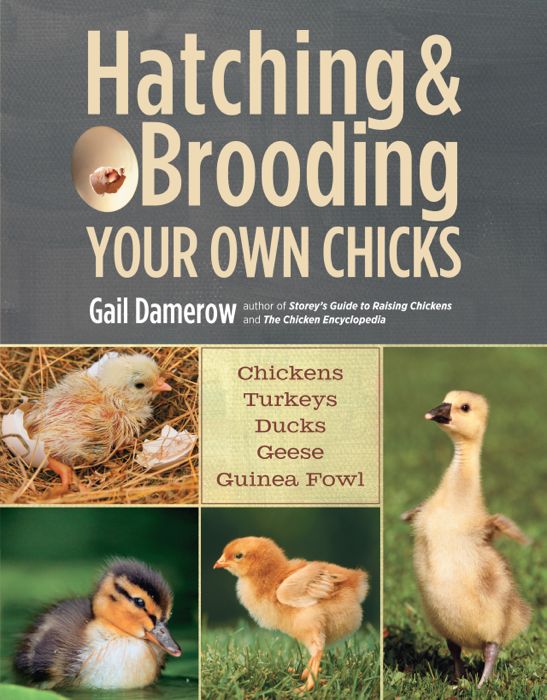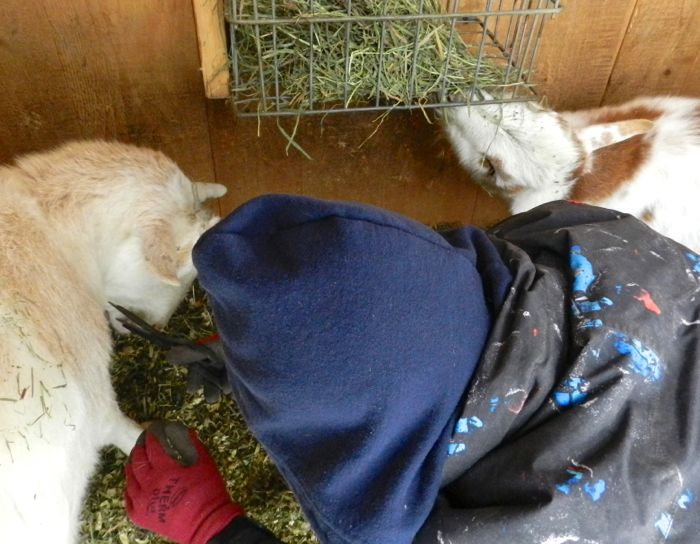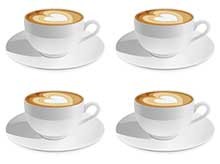It’s hard to get anything done when the dogs are sending out such strong sleep waves. Too bad they haven’t left any room in the sun for me.
Weasel Tracks
Early this morning when I went out to the barn, I noticed Lily sniffing in the snow. I went over to see what interested her and found these tracks.
A weasel. I’m not knowledgeable enough to know which member of the mustelidae family it was. I rely on Tracking and the Art of Seeing by Paul Rezendes to guide me. My best guess is that the visitor was a long-tailed weasel, a lithe and agile predator, that turns the color of snow in the winter.
It was 10 degrees F this morning when I told Steve about the tracks. While I drank my coffee, he went out with the camera to see if the tracks would reveal a story. They did.
The weasel came onto the property by climbing a tree and then jumping onto the Small Barn’s fence post.
It leapt from post to post,
and then landed lightly on the ground,
hurried along the front of the Big Barn, sat a spell on the Adirondack chair,
crossed the yard, traveled along the top of the perennial flower garden’s fence,
and disappeared into the woods.
The chickens were closed up safely for the night, which is a good thing, or there’d be fewer hens this morning.
Book Giveaway!
This contest is closed. Congratulations to Ruth and your 4-H club!
Gail Damerow has a new book out, and I have one copy to giveaway! Damerow has been dispensing sane, solid advice through her books for many years. I still turn to her first when I have something going on in my flock that I haven’t experienced before (after almost 20 years of hen keeping that still happens!) Her new book, Hatching & Brooding Your Own Chicks, is classic Damerow – well-organized, sensible and practical. In it, you’ll learn the basics of chick raising and care. But, I have to say that my favorite section is at the end and titled Screwpot Notions. Among other pseudo-facts, she dubunks sexing myths and herbal cures for coccidia. What with the proliferation of just plain wrong advice on the internet (not my site!), these few pages are essential reads for the confused and gullible.
My copy arrived just in time, as I’ll be at the Chelmsford, MA Agway on Saturday, Feb 16 (tomorrow! rescheduled from last week due to the snowstorm) to give a lecture on chick care. I’ll be talking about chick orders, breed selection, and what to do when you get the chicks home from the feed store. I haven’t raised other poultry, such as turkeys, but the Agway will have them in this spring. Damerow’s book covers poult (baby turkey) care as well as waterfowl, so I’ll have the book with me.
To win a copy of Hatching & Brooding Your Own Chicks, simply leave a comment below and let me know if you’ll be getting little peeps this spring. If you’re not, that’s okay, enter anyway! (You can let me know what you would get if you were to get chicks.) If you share on FaceBook or Twitter, let me know by leaving a second entry. The winner will be selected by a random number generator on Tuesday, February 19 at 10 pm EST. The book will be shipped directly from the publisher. Good luck!
Love, Chickens and the Ikea Effect
Last week I heard a piece on the radio about the Ikea Effect. Basically, the Ikea Effect says that labor done by the purchaser adds to a higher valuation of the product. Food manufacturers could easily make cake mixes that require only the stirring in of water, but instead, they formulate the product to require eggs: cracking an egg and mixing it into the batter makes the consumer feel that she has baked a better cake. When we work to build a bookshelf (however crooked it turns out) we value it more than a similar shelf that we haven’t made. This concept expands beyond consumer satisfaction. We get attached to things that we work hard at, whether it is an idea, or a model airplane.
I take this further. I believe that work increases love. Do I take such good care of my chickens because I love them? Truthfully, that’s only part of it. The flip side is that I love the work of taking care of chickens. Today is a beautiful, mild winter day. I am out in the barns, wearing just a sweater, my eyes squinted against the brilliant white light bouncing off of the snow. I clean and fill waterers, add sand to the dust bath, cut the goats a pine branch to snack on, toss alfalfa to the Gems, and fill the oyster shell dispenser. I sweep the barn floor, and scoop dog poo off of the shoveled path. My animals appreciate my efforts. We interact and talk to each other. This work feels satisfying. I feel useful. It gives my day value. The love for my animals increases because of the work that I do caring for them. We don’t love in a vacuum. We love within the context of our interactions and effort expended. The love that I get from my animals doesn’t satisfy me half as much as the work that I do for them in the name of love.
Sometimes, the Ikea Effect doesn’t help the animals. Do people change their schedules and lives to accommodate the neediness of their rescue dogs out of love for those dogs OR do they love those dogs even more because they require such effort – and therefore make excuses for their pets and don’t, in the end, alleviate the issues? When a chicken is separated from the flock for an illness, and we spend days nursing her back to health, does she then become a favorite – and sometimes isn’t put back into the coop because we feel good about the intense caring that we are doing?
Lately, I have been dreaming about owning a horse again (thanks to a ride on a most wonderful Ranch Tennessee Walker.) I imagine outings on horseback in the woods (always in perfect weather and without deer flies bothering us), but mostly I daydream about the work. The grooming, the mucking, the saddle cleaning. I think about the smell of the barn and the quiet time caring for a horse. Maybe this is why I’m not one of those people who spend hours on the internet looking at cute pictures of kittens (or chickens.) Separated from the work of love, it’s fleetingly interesting, but ultimately not satisfying. Put a manure fork in my hand. That’s love.
(If you liked this essay, please consider sharing it by using the icons on this page.)
Goat Beard Trim
I’m surprised that no one has noticed the goats’ new beard styles.
Their beards had been dragging in snow and muck, freezing and thawing, and I didn’t want the goaties’ chins to be wet and cold. Caper was looking particularly disreputable .
So, I distracted the boys with some hay and did a quick snip. The good scissors are in the garden shed, blocked by three feet of snow, so I used the shears that I cut the hay bale twine with.
I hacked away and got the job done. Not the most stylish beard trim (it looks a bit like a botched fu manchu), but it doesn’t matter. Caper always looks handsome.


